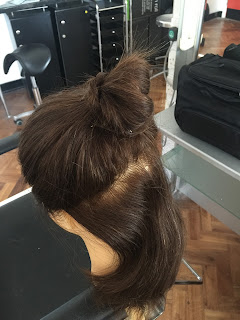The first plait we learnt was the basic 3 strand plait, this is a plait that most people know how to do, and it is super simple!
What you will need:
- Pintail Comb
- Hair Bobbles
- Hair Brush
- Brush the hair
- Take a section of the hair that you wish to plait
- Split this section into 3 parts and hold with your fingers
- Starting from the top wrap the sections over one another, so, if you start with the left section you wrap it over the middle so that the original middle is now on the left, then you wrap the right over the middle section, repeat this until you have no more hair to plait
- Secure the bottom with a hair bobble
The next plait that we learnt was a french plait, this is a lot harder to do as you have to take extra parts of the hair into the plait whilst keeping it tight.
What you will need:
- Hair Brush
- Pintail Comb
- Hair Bobbles
- Take a section of the hair that you wish to plait, make sure this section is a bit larger than that of your 3 strand plait
- Starting from the top of the head, take a layer and split it into 3 sections
- Plait this once just like you did for the 3 strand plait
- Now when you go to do the second plait take a section of hair closest to the end of the section you just plaited and add it to that section
- Do this for all 3 sections when plaiting and carry this on until you have no more hair to plait
- Keep the plait very tight to the head as you can otherwise have a lot of loose hair and it won't look very smart
- Secure bottom with a hair bobble
 |
| My first attempt at a french plait with just a section of hair chosen |
 |
| My attempt at a full head french plait, it is a bit loose and I need to practice my tightness more |
The last plait we learnt to do was a fishtail plait, I find this plait a lot easier than the french plait as there aren't as many sections you need to worry about.
What you will need:
- Pintail Comb
- Hairbrush
- Hair bobble
- Brush the hair
- Take a section of hair you wish to use and split it into two parts
- Take a small section from the back of one half of the hair, and pull it over its own section passing it to the other section. This now stays with its opposite section
- Do the same from the other section now, and repeat it until you have no more hair to plait
- This plait doesn't need to be really tight, it looks worse the more tight it is
- Secure with a hair bobble

























